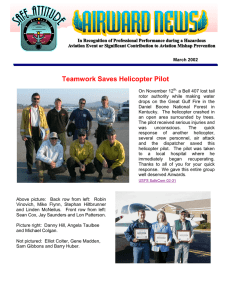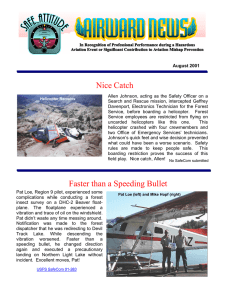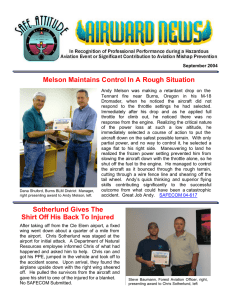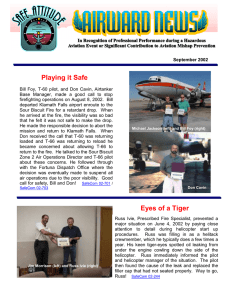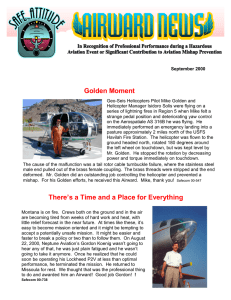June SAFECOM Summary SAFECOMS by Type & Category
advertisement
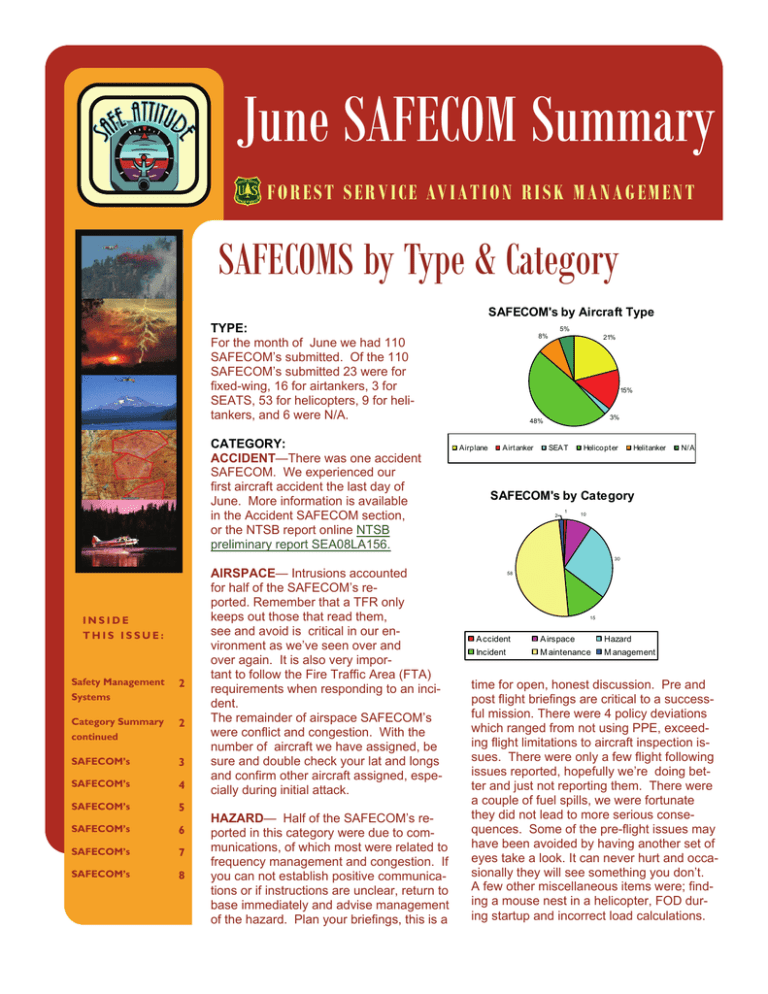
June SAFECOM Summary
F O R E S T S E R V I C E AV I AT I O N R I S K M A N A G E M E N T
SAFECOMS by Type & Category
SAFECOM's by Aircraft Type
TYPE:
For the month of June we had 110
SAFECOM’s submitted. Of the 110
SAFECOM’s submitted 23 were for
fixed-wing, 16 for airtankers, 3 for
SEATS, 53 for helicopters, 9 for helitankers, and 6 were N/A.
CATEGORY:
ACCIDENT—There was one accident
SAFECOM. We experienced our
first aircraft accident the last day of
June. More information is available
in the Accident SAFECOM section,
or the NTSB report online NTSB
preliminary report SEA08LA156.
5%
8%
21%
15%
3%
48%
Airplane
Airt anker
SEAT
Helicopt er
Helitanker
N/ A
SAFECOM's by Category
2
1
10
30
INSIDE
THIS ISSUE:
Safety Management
Systems
2
Category Summary
continued
2
SAFECOM’s
3
SAFECOM’s
4
SAFECOM’s
5
SAFECOM’s
6
SAFECOM’s
7
SAFECOM’s
8
AIRSPACE— Intrusions accounted
for half of the SAFECOM’s reported. Remember that a TFR only
keeps out those that read them,
see and avoid is critical in our environment as we’ve seen over and
over again. It is also very important to follow the Fire Traffic Area (FTA)
requirements when responding to an incident.
The remainder of airspace SAFECOM’s
were conflict and congestion. With the
number of aircraft we have assigned, be
sure and double check your lat and longs
and confirm other aircraft assigned, especially during initial attack.
HAZARD— Half of the SAFECOM’s reported in this category were due to communications, of which most were related to
frequency management and congestion. If
you can not establish positive communications or if instructions are unclear, return to
base immediately and advise management
of the hazard. Plan your briefings, this is a
58
15
A ccident
A irspace
Hazard
Incident
M aintenance
M anagement
time for open, honest discussion. Pre and
post flight briefings are critical to a successful mission. There were 4 policy deviations
which ranged from not using PPE, exceeding flight limitations to aircraft inspection issues. There were only a few flight following
issues reported, hopefully we’re doing better and just not reporting them. There were
a couple of fuel spills, we were fortunate
they did not lead to more serious consequences. Some of the pre-flight issues may
have been avoided by having another set of
eyes take a look. It can never hurt and occasionally they will see something you don’t.
A few other miscellaneous items were; finding a mouse nest in a helicopter, FOD during startup and incorrect load calculations.
PAGE
T H E
2
Safety Management System
The Forest Service Aviation Risk Management Branch has been in the process of
adopting the International Civil Aviation
Organization (ICAO) and Federal Aviation
Administration (FAA) Safety Management
System (SMS) for the past four years. We
have recently implemented several key
elements of the program. Program Risk
Assessments were completed over the
past couple of years on most of our aviation programs. Theses were distributed to
the regions to distribute to the forests and
aviation operational bases early this summer. These Risk Assessments should be
used in conjunction with your daily operations and flight planning. If you have not
S A F E C O M
S Y S T E M
I S
O N E
T H E
O F
B E S T
A V I A T I O N
A C C I D E N T
P R E V E N T I O N
T O O L S
W E
H A V E .
T O
R E P O R T
A I R S P A C E
I S S U E S ,
I N C I D E N T S ,
H A Z A R D S ,
M A I N T E N A N C E
D E F I C I E N C I E S
G O O D
A N D
P R E V E N T I O N
I D E A S
L O G
O N
T O
W W W . S A F E C O M . G O V
SAFECOM
SAFECOM’s by Category continued
INCIDENT—-What we saw in the Incident SAFECOM’s were early indications of
fatigue, loss of situational awareness, inattention to detail and urgency of the
situation. SLOW DOWN, if you can’t get there safely, you sure aren’t going to
help the situation, and often can cause more problems. Perform thorough preflight inspections and briefings. There were two dropped loads and three dragged
loads. Perform thorough risk assessments when working in smoky conditions,
longline operations in particular. Think of being in a sea of ice, you’re only seeing
the tip of the iceberg. Remind the pilots not to descend below the canopy or to
operate in an opening of less than 1 1/2 times the main rotor diameter. There
were three precautionary landings, due to loss of electrical power, lack of power
and power fluctuations from ash and smoke.
MAINTENANCE— There were 58 SAFECOM’s reported on maintenance issues.
The most reported was engine problems. Several reports of problems due to intake of ash and smoke. There were 8 reports of avionic problems, 7 reports of
electrical issues and 5 reports of landing gear problems. The number of chip
lights reported (5) was abnormally low, they are generally one of the most reported mechanical SAFECOM’s.
Flying in
smoky conditions can be
like a sea of
ice, you only
see the tip of
the iceberg.
JUNE
received a copy please contact your Regional Aviation Safety Manager or you
can download the Risk Assessment Guide
online at: http://www.fs.fed.us/fire/
av_safety/Systems_Safety/
av_risk_mgt/08SSA_Guide.pdf
We also included new safety program requirements in several of the new contracts
this year. Vendors are now required to
submit a copy of their Safety Program,
and it is evaluated and weighted in the
contract award process. We intend to get
these requirements in all of the contracts
by next year.
MANAGEMENT— There were two of these reports, one having to do with log
book documentation and the other with avionic inspections.
SUMMARY
FOREST
SERVICE
AVIATION
RISK
MANAGEMENT
PAGE
3
SAFECOM’s
SAFECOM 08–0436 The Cessna TR182 RG was substantially damaged during a forced landing approximately 9 miles southeast of
Bend Oregon. The pilot sustained serious injuries, the observer sustained minor injuries. The flight had departed Redmond, Oregon
about 1530. The pilot reported detecting an unusual vibration as she
descended from 7,500 feet while returning to base after conducting a
local reconnaissance flight. The pilot reported that the vibration continued to become strong, accompanied by the propeller RPM “in the
red” and rising engine oil temperature. Oil began to streak the windscreen and the pilot shut down the engine and initiated a forced landing to a nearby grassy field. During the landing the aircraft struck a
barbed wire fence and came to a stop on highway 20. A Forest Service investigation team has been assigned
and will be party to the NTSB investigation.
SAFECOM 08-0435 Helicopter HXXX was ordered for initial attack for a new
start on the XXXX Complex on the XXXX /XXXX forest border. When asked if
any other aircraft would be responding the XXXX Helibase said no, when we
lifted we checked with in with XXXX Dispatch and flight followed with them. Air
attack was not launched. When HXXX responded to the area of the new start
the inversion was still pretty thick. We called 12 and 7 miles out on IA victor to
make sure no aircraft were in the area. As we approached the Lat/Long the
squadleader in the back noticed a jump plane at 3:00 high 1/4 mile out. We
made several attempts to contact the jump plane on IA victor, XXXX Complex
victor, XXXX Complex victor, and Airgaurd with no response. When we made
contact with the jump plane they told us there was another jump plane circling
as well. Due to the inversion, smoky conditions, and terrain we could not
maintain visual contact with both planes and decided to leave the area. We
discussed with the jumpers our egress. When we were about to leave the
area, XXXX dispatch called and advised us there were Jumpers in the area.
Any fire in the border areas while we have several complexes and forest IA's
should have air attack launched. XXX and XXXX dispatch have to do a better
job of communicating with each other when they know aircraft are in that border area. Jumpers need to be monitoring Airgaurd even in jump ops. Stress
the importance of Helicopter Crewmembers looking for other aircraft enroute
to incidents. Acting RASM Remarks: This incident, while unfortunate, is a
great reminder why we have boarder plans in place. The following information
needs to be conveyed to any surrounding border (Such as other TFR's, other Forest/district/unit boundaries or
fires, etc...) 1) Have the Neighboring dispatch centers been notified of your response? 2) Have common frequencies been assigned to all responding aircraft? 3) If extended attack, have dispatch centers agreed on the single
order point for incident resources? 4) Are flight crews aware of order point and flight following center? 5) Do you
have an existing TFR on your unit? Have you notified cooperating Agencies? & 6) Are there MTRs or SUAs in the
Incident area? Have the crews been informed? Lets work together to avoid this situation from happening again!
Lesson learned! I'll contact adjoining dispatch centers for further follow-up.
SAFECOM 08-0402 At 1127 hours {PDT} the XXX Canyon Helibase at the XXX Canyon Airport, which was supporting both the XXXX Complex and the XXXX Complex, was notified that an unknown fixed-wing airplane flew
through and violated the temporary flight restriction {TFR}, which was effective at 0600 PDT. The aircraft could
not be identified. No further information at this time. RASM: TFR's only offer you protection from the pilots that
read them and pay attention to them, they are no guarantee that aircraft will not intrude on them. Keep your eyes
open for other aircraft all the time.
JUNE
SAFECOM
SUMMARY
FOREST
SERVICE
AVIATION
RISK
MANAGEMENT
SAFECOM’s continued…...
PAGE
4
SAFECOM 08-0350 June 20,2008 at 1507 a Cessna 182 intruded the TFR unannounced from the south and
west side of the Corn Creek Fire, the TCAS was unable to detect the aircraft, the ATGS aircraft was at 11,000 ft
and the intruder aircraft was at 10,700 causing a near miss. The pilot made an evasive maneuver to avoid intruding aircraft to avoid collision. RASM: Good heads up practice of see and avoid along with situational awareness. NOTE: Many VFR aircraft do not have/use transponders and are therefore not visible on TCAS.
SAFECOM 08-0513 Communication issue on incident on the XXXXX N.F; the communication problem occurred
between the helicopter and ground personnel during a sling load supply mission. The fire was staffed on June
30th 2008. A request was made through XXXX dispatch on the evening of the 30th for blivets, hoses, food and
water to be delivered by a sling load to the fire. On the evening of July 1st dispatch called and to say helicopter
was fifteen minuets out from our location. Once we could hear the helicopter, we began to try to contact him on
air to ground. We could not reach the helicopter on air to ground, so another try was made on air guard. Again we
were unable to communicate with the helicopter. At this point dispatch was contacted, and asked to verify the air
to ground frequency. Dispatch gave a different air to ground frequency than what was preprogrammed into our
radio which is the published primary air to ground for the IA zone. We hand programmed our radios and then
started talking to the helicopter with out any other problems. During the time when we were trying to contact dispatch and establish contact with the helicopter the helicopter had to circle the fire with the sling load. The elapsed
time was approximately fifteen minutes from the time we first tried to contact the helicopter and when we finally
made contact. UAO Comments: Assigned frequency was not on the resource order. Proper procedure (Air
Guard call) was conducted by ground personnel, but why the Air Guard call from ground resources wasn't heard
by pilot is unknown. Air Guard was checked to be working properly after the event. Regional Safety Alert related
to incident tactical frequency verification and communication between dispatch and aerial resources is being issued soon. RASM Comment: The resource order used to dispatch this mission, did not have an air-to-ground frequency. This load of jumpers was split when they arrived over the first fire. Four jumpers were put on that first fire
with 4 more jumpers diverted to the second fire. All the jumpers had programmed their radios with the frequencies
shown on the regional zone map. Dispatch did not communicate any air-to-ground frequencies to the flight crew
or to the jumpers. The forest and helicopter conducting the longline mission were operating on a frequency not
published on the Pacific Northwest Aviation Frequency Guide Map. It appears that the forest radios had been incorrectly programmed so now the regional published frequency information was incorrect. A Regional Safety
Alert, R6-08-01, was sent out on 7/9/2008 to address this problem.
SAFECOM 08-0388 Around 1530 HXXX lifted off from XXXX Airport to return to the incident. The pilot failed to
contact Forest Dispatch or XXX Air Attack and did not follow agency flight following procedures. When he was
unable to find a route to the fire he returned to XXXX. Around 1620 I was able to make contact with the pilot via
cell phone. During this time frame we had no positive communications with the aircraft. Explained to the pilot that
it is his responsibility to follow procedures to ensure good communication on fire incidents and to maintain agency
flight following. RASM: Corrective action is appropriate, it is important for all of our pilots to be made aware of
this. NASS: This is exactly how the system is suppose to work, the submitter took immediate corrective action by
having discussion with the pilot and then documenting in a SAFECOM.
SAFECOM 08-0322 At approximately 1845, H-XXX was in the dip and had approximately 200 gallons of water
loaded in the tank when the snorkel hose developed a leak just below the camlock at the upper end of the hose.
The hose unraveled to the point that the hydraulic hoses kept it from unraveling any futher. The dipsite manager
noticed the leak and got the attention of the pilot. The pilot recognized the situation at the same time and asked
the dipsite manager if he thought the snorkel would stay attached to fly back to helibase. The dipsite manager
informed the pilot that he could not make that decision. Pilot flew in a circle to get a better view of the snorkle and
determined that it would hold together for the flight back to helibase. Aircraft landed at helibase at 1900. Upon
inspection of the snorkel by the pilot and company mechanic, they suspect that the design of the attachment point
of the snorkel causes stress to the hose upon landing. Snorkel will be replaced. Regional maintenance inspectors
were notified and will follow-up on the snorkel attachment. RASM: Appropriate response by the Dipsite Manager
not to comment/approve on the airworthiness of the snorkel. FFMO: I concur with all.
JUNE
SAFECOM
SUMMARY
FOREST
SERVICE
AVIATION
RISK
MANAGEMENT
SAFECOM’s continued…...
PAGE
5
SAFECOM 08-376 At 1455, Tanker xx was ordered by the yyyyyy dispatch center to a fire on the zzzz National Forest.
They responded out of ATB for the A-8 fire. T-xx called ATB asking to confirm the frequencies because he was not getting an answer on any of them. The dispatcher called yyyyyyy to clarify the frequencies. The phone rang approximately
15 times with no answer. She then called the GACC to get clarification on the frequencies. The receptionist answered
the phone & she asked for the aircraft desk. She was put on hold for about 5 minutes. When the phone was finally answered she was told that the air attack was down mechanical and that B-zz was ordered. The pilot called in and said that
he was returning to ATB to jettison. He stated that the smoky conditions were degrading and that it was a safety issue.
He also stated that he was still unable to contact B-zz at about 5 minutes out from ATB. B-zz lifted off of ATB and T-zz
told him that he was going to jettison and would not return to the fire because of the smoky conditions. Load was jettisoned at jettison area. Pilot requested that aircraft not be dispatched to fires in such severely smoky conditions without
an air attack, lead or Bravo on scene. RASM Comments: This incident prompted a Regional Interagency Safety Alert
concerning the dispatch of airtankers to fires during the adverse visibility conditions. PIC's always have the authority and
responsibility to turn down or abort a mission if they are uncomfortable with it.
SAFECOM 08-372 On the XXXX fire at approximately 1600, the plan was to perform a crew shuttle from one helispot to
a landing zone on the fire line with a 20 person handcrew. The handcrew received a helicopter passenger briefing before
the shuttle began. On the third of five trips, the helicopter was approaching the LZ {about 10 feet from the ground} when
he suddenly dropped so the skids were about five feet from the ground and the tail was two to three feet from the
ground. Upon questioning the pilot on what happened he stated a sawyer riding up front with his saw chaps on quickly
moved his leg and the chaps snagged the collective from his hand and caused the helicopter to drop. Pilot did a good job
of quickly pulling the collective back up and landed safely on the pad. Anyone wearing chaps or any other loose material
on their legs will ride in the back seat of the Helicopter. Also when giving a briefing, helitack will stress the importance of
not moving around in the helicopter. RASM comments: Kudos to the pilot who was prepared for the unexpected and reacted quickly to the situation. This is a good reminder for folks to brief passengers on keeping clear of the controls. It
also reminds us to keep a heads up when an aircraft is coming into the landing zone. Fortunately this event turned out
favorably.
SAFECOM 08-0304 While examining load calcs from the previous day''s flight I noticed an actual payload amount that
seemed low for the personnel that were on the flight. Upon further investigation we found the weights of three of 18 crew
members were not entered in our load calc program. Flight ops from June 3 thru 6 had incorrect weights on the load
calcs involving those three crew members. UAO Note: The load calcs and dispatch logs for June 3 to June 6 were examined and load calcs recalculated using the updated weights for all crew members. It was found that there were two flights
where the load calculations would have exceeded the allowable payload by 70 and 95 pounds. Fortunately, both of
those flights took off with less fuel than the amount used for the load calc and resulted in being within limits by 20 and
251 pounds. Most load calculations for this project use the maximum allowable fuel for the payload even though there is
generally less fuel on board the aircraft. All personnel were again weighed accurately and the database was updated.
Data checks will be implemented to prevent completion of load calc without weights for all pax on the flight. As part of
completing load calcs, we realize we need to insure weights recorded are representative of the actual weights loaded.
SAFECOM 08-0399 T-XXX was on a load and return having departed from XXX @ 1836 enroute to the XXX XXX Incident on the XXXX NF. T-XXX was approximately 10 km east of XXXXX. While flying in light turbulence the pilot changed
hands on the control stick and inadvertently tripped the release trigger releasing part of his load {600 gallons}. T-XXX
turned back and marked his location with GPS and then returned to XXX. T-XXX was flying at approximately 4500'' AGL.
The XXX Ranger District, XXXX National Forest, was contacted about the inadvertent drop of retardant and they were
going to make an on-the-ground inspection of the area to assure that the retardant did not negatively impact any resources or property. The SEAT Manager and Air Center Manager talked with the pilot about the need to exercise extreme caution when enroute to an incident. We talked about the need to adhere to the pre-drop checklist and to maintain
strict attention to procedures during episodes of turbulence. RASM: Pilot took correct action in returning to mark the spot
of the dropped load then reporting the event. The follow up discussions were appropriate to the situation.
SAFECOM 08-390 Helicopter left helibase enroute to XXXX fire, Division H. In flight the pilot experienced a power
fluxuation and immediately returned to base. Helicopter landed safely, no injuries and no damage. Mechanic diagnosed
the problem and found the engine needed a power wash. After washing the engine the pilot went for a test flight and the
problem was solved. Per mechanic, problem was caused by intake of dust and ash from the fire.
JUNE
SAFECOM
SUMMARY
FOREST
SERVICE
AVIATION
RISK
MANAGEMENT
SAFECOM’s continued…...
PAGE
6
SAFECOM 08-0342 At approximately 2 hours into the mission over the XXXX Fire, the pilot noticed warning flags on the
heading indicator that indicated a possible electrical problem. The pilot checked the amp & volt meter and they both indicated a charge. A few minutes later the TCAS circuit breaker popped. After waiting and resetting the circuit breaker it
popped again. Shortly thereafter we noticed a humming noise in the avionics system coming through our headsets. Next
we noticed the screens on the radios were flashing and we lost power to them. At this point we realized we were loosing
electrical power and suspected the alternators had failed and we were running low on battery power. We immediately
departed the incident for the base. We squawked 7600 on the transponder and I made a cell call once in cell range to
advise of our situation. Pilot conversed with companies’ chief mechanic and determined the Alternator switches were in
a dead position. The Alternator switches have been placarded and plans to replace the switches at the next 50hr inspection have been made to eliminate future occurrences. The aircraft has been inspected by a Airframe and Powerplant Mechanic at XXXX Aviation on the airfield and found to be in accordance with Part 135 operations and no discrepancies at
this time. AMD was notified and aircraft returned to service the following morning. RASM: Good decision on behalf of the
pilot and ATGS to not extend the mission. Vendor should use as a lesson learned and placard all questionable switches.
Safecom 08-0335 While on the XXXX fire the XXXX Hotshots and YYY Hotshots were in XXX Canyon constructing
hotline and requested helicopter bucket support. The YYY Assistant made contact with the helicopter and instructed him
where to drop. The two crews were clear of the line and maintained situational awarness of the helicopters actions. The
helicopter came in from down canyon at a low level with bucket attached. The helicopter continued to drop in elevation
and split the crews in half with bucket dragging across the ground nearly hitting more than one person. HOS Comments:
06/25/2008 I spoke with the National Guard on this incident; they will do a briefing with all crews on this matter even
those not involved on this incident. The main issue is to maintain situational awareness and proper drop height even if
that means maintaining a 100 ft. AGL. or higher also to reaffirm that the area is clear before a live run. The National
Guard will also conduct additional training with their crews. National Guard Response:06/27/08 I did find out who the
crews were and discussed the situation with the PC. They got busy looking for the ground crews and flying through the
canyon. I have reiterated to all 3 crew members their responsibility in aircraft control and proper bucket heights, as well
as the safety issues of positive ID of ground crews before making a water drop. We are going to bring this up in our next
stands meeting for all of our Instructor pilots, we will use this as an example for all future training that we do. Again I am
very glad no one on the ground or air was injured. The National Guard conducted an Operational Hazard Report (OHR)
with the following actions: 11. INVESTIGATION AND RECOMMENDATIONS: The aircrew members while flying up the
canyon toward the ground crews got fixated outside the aircraft and the crewmember in the back was not watching the
bucket and was looking elsewhere. The canyon was rising quickly and the non flying pilot did not cross check the radar
altimeter. The crew as a whole was fixated and not paying attention to the hard deck on the radar altimeter. The crew
only noticed as the crew chief in the back announced they had spilled some water from the bucket and that it had hit the
ground. The flying pilot immediately increased the cyclic to gain altitude. There was a crew coordination failure here with
lack of cross monitoring, and not splitting the duties correctly. Recommend that the pilots talk about the incident at the
next safety meeting and that we go over the set hard deck and the necessity of cross monitoring. 12. ACTION TAKEN
TO CORRECT THIS HAZARD: The AASF will ensure that this becomes a key lesson learned for future fire operations.
This can be prevented by thorough crew brief utilizing a no-lower than altitude (in this case, 100’ for UH-60 operations).
In addition, the non-flying pilot will be specifically briefed to cross-monitor performance and make collective inputs to ensure minimum altitude is maintained.
Have you mitigated all
your hazards today?
SAFECOM 08-0313 Type two helicopter was performing crew transport from H-1 to ICP helispot on the XXXX Fire. The
helicopter experienced a bird strike to the upper left pilot window area while in flight to the ICP helispot. Pilot felt no vibration in the aircraft and safely landed the helicopter at the ICP helispot. No damage was done to aircraft. Corrective
action that took place: The AOBD and ATGS were notified and were on scene. Regional aviation maintenance inspector
was notified and received engineering report via fax. The mechanic and Helicopter manager inspected the aircraft window frame and found no damage. Helicopter was put back in service. RASM: Good decision by the pilot to land the aircraft rather than assuming everything was OK and returning to the main Helibase.
JUNE
SAFECOM
SUMMARY
FOREST
SERVICE
AVIATION
RISK
MANAGEMENT
SAFECOM’s continued…...
PAGE
7
SAFECOM 08-0269 On the first day of the contract for the 2008 season, while performing mock-up rappel operations out
of the Bell 407 (with the rear seat modification kit {#}CT 407-04-61) the inside hinge of the bottom seat cushion became
disengaged from the holding fixture when the rappellers left their seats to go out to the skids. As the rappellers reentered the aircraft the seat bottom was bumped with a knee causing the seat cushion to disengage from both holding
fixtures. Rappel operations were stopped. The Region Maintenance Program Manager contacted Bell Helicopter to explain the problem but Bell Helicopter had no recommendations. A temporary repair was devised by the RX and RX Maintenance Program Managers; safety wire was added to the seat bottom around the holding fixture to secure the seat bottom to the holding fixtures. They referenced to AC 43.13 Appendix A - this fix to the seats is considered a minor alteration and can be complied with and signed-off by an A&P mechanic. Bell Helicopter was advised of the temporary fix. The
National Aviation Risk Management office was also notified. UAO Comments: I was on site the day of incident, and Rappel Spotter in charge kept me well informed on situation, immediate follow up actions, and notifications being made.
SAFECOM 08-0424 Helicopter lifted off airport for third mission of the day. Within a minute or two of lift off, pilots smelled
fuel then saw it spraying out near engines. They immediately turned around, landed and shut down. The rescue truck
responded and there was some fuel spilled onto the landing area, there was no fire. The problem was a plug came out of
the fuel control on the number 2 engine. The clip that holds the plug in place was not present. The number 2 engine was
replaced including the fuel control with an overhauled one on 6/21/08, 28.3 hours have been flown since the overhaul.
The engine and fuel control was overhauled by xxxxx yyyyy. The Fuel Control was replaced. The company will be following up with overhaul company. Agency Maintenance inspector was notified. RASM Comments: This was a potentially
very serious situation. I'm not sure if the clip or the plug are visible during pre-flight, but should be checked to assure security of the plug if it is visible.
SAFECOM 08-0408 Approximately 43 NM E. of XXX enroute XXXX Fire, pilot experienced abnormal engine indications
{high inter-turbine temperature {ITT}}. Pilot jettisoned load, declared IFE and climbed to 14000 feet MSL to ensure safe
recovery to Air Attack Base. Aircraft was landed without incident. ITT gauge was determined to be malfunctioning and
was removed and replaced IAW Air Tractor maintenance procedures.
SAFECOM 08-0407 Copter xxx was dispatched to the XXX Fire, North of the XXX Complex for insertion of Rappellers.
After locating the fire and sizing it up, Copter xxx''s C-box temp light illuminated on the Master Caution panel. Although
the light was illuminated, the gauge showed 2 degrees below red line, but 3 degrees above normal. The rappel mission
was subsequently ''aborted'' and Copter xxx returned to Helibase. Upon reduction of power and forward flight the light
went out and the temp went back to normal allowing us to return to helibase. Once at helibase the oil coolers were
cleaned (due to flying in excessively smokey conditions) and the problem was solved.
SAFECOM 08-0378 Upon return to XXXX Tanker base, Tanker had complete landing hydraulic gear failure do to a ruptured hydraulic line on the right main. He followed the emergency check list procedures and all went well. The landing
gear dropped and he was able to land safely. A large Thank You to the XXX Crash Rescue and to the Air Field Tower
personnel for the outstanding assistance with the situation. The crew chief was able to remove and replace the hydraulic
line in the right wheel well due to a cracked line. Once the line was replaced, hydraulic pressure was checked and it was
okay. Filters were also checked and they were good. The pilot and crew chief approved aircraft back into service. R-X
Aircraft Maintenance / Safety inspector was advised of the situation on the Tanker. After review, AMI placed the aircraft
back into contract service. RASM comments: Glad this situation turned out well. Kudos to the pilots. No further action
required.
SAFECOM 08-0355 Approximately 0700 hrs: The contractor mechanic on a Bell 205 A1 was performing his daily maintenance inspection, when he noticed two bolts from the engine bracket mount were sheared off. The Bracket mount was
located on the right side of the aircraft. The Regional Maintenace Inspector was informed of the situation. The mechanic
notified his home office of the situation and the bolts were replaced. The company chose to initiate a fleet replacement of
the bolts to prevent further situations within their fleet. RASM: Good pickup by the Mechanic, Thanks
JUNE
SAFECOM
SUMMARY
FOREST
SERVICE
AVIATION
RISK
MANAGEMENT
SAFECOM’s continued…...
PAGE
8
SAFECOM 08-0323 Upon review of maintenance log book the mechanic noticed that a required engine oil change had
not been documented in the maintenance log book for the aircraft. The mechanic was unable to contact the previous
mechanic who had performed the 100 hr. and oil change. Mechanic decided to change oil due to the unknown status/
documentation of last oil change. Oil changed and documented in aircraft maintenance log book. Helicopter manager
reviewed logbook entry, contacted R-X maintenance inspector, faxed copy of log entry to R-X maintenance inspector,
returned aircraft to contract availability. Pilot and mechanic performed aircraft run-up and leak check with no issues. Mechanic returned aircraft to service. RASM Comments: A big thank you to the mechanic on this one, both for being
through and finding this discrepancy and also for doing the right thing and assuring that the proper servicing got done,
(even if duplicated) and documented correctly.
SAFECOM 08-0316 During the morning pilot/ mechanic pre-flight check, a mouse with a nest of mice was discovered in
the co-pilot side cargo compartment. This compartment is checked daily by the pilot and mechanic. The helitack crew is
responsible for checking the tail boom compartment, the passenger compartment, and the cargo basket. Nothing was
found in any compartment during the previous days'' pre-flight inspection. The mechanic removed the aircraft's inspection panels and the belly pans, to look for the mouse, or damage it might have caused, none was found. Discussed with
the flight crew and helitack crew the importance of checking the aircraft's compartments daily and often due to possible
damage from rodent infestation, as it has been a problem in the past. RASM comments: This is a good head's up reminder that in periods of inactivity, to check for rodents and insects as well as mechanical issues.
Thanks go out to all the folks that submitted SAFECOM’s.
Sharing this information with others for prevention purposes
is very important and appreciated.
Keep up the good work and FLY SAFE.
JUNE
SAFECOM
SUMMARY
FOREST
SERVICE
AVIATION
RISK
MANAGEMENT
